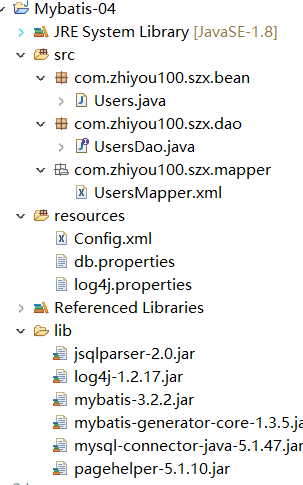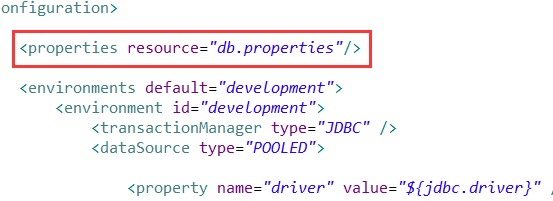mybatis总结
一、mybatis简介
二、创建一个demo

1、加入jar包

2、创建mybatis的配置文件
<?xml version="1.0" encoding="UTF-8"?>
<!DOCTYPE configuration PUBLIC "-//mybatis.org//DTD Config 3.0//EN"
"http://mybatis.org/dtd/mybatis-3-config.dtd">
<!-- 数据源的信息:数据库的信息。 -->
<configuration>
<properties resource="db.properties"/>
<environments default="development">
<environment id="development">
<transactionManager type="JDBC" />
<dataSource type="POOLED">
<property name="driver" value="${jdbc.driver}" />
<property name="url" value="${jdbc.url}" />
<property name="username" value="${jdbc.username}" />
<property name="password" value="${jdbc.password}" />
</dataSource>
</environment>
</environments>
<mappers>
<mapper resource="com/zhiyou100/szx/mapper/UsersMapper.xml"/>
</mappers>
</configuration>
3、优化Config.xml文件
将数据库的连接信息单独放在一个新的文件中,文件名为,db.properties
jdbc.driver=com.mysql.jdbc.Driver
jdbc.url=jdbc:mysql://localhost:3306/mybatis
jdbc.username=root
jdbc.password=123123
在配置文件中引用。

4.添加日志信息
添加jar包。

在资源包resources中添加文件log4j.properties。(名字不可改变)下列为内容。
log4j.properties,
log4j.rootLogger=DEBUG, Console
#Console
log4j.appender.Console=org.apache.log4j.ConsoleAppender
log4j.appender.Console.layout=org.apache.log4j.PatternLayout
log4j.appender.Console.layout.ConversionPattern=%d [%t] %-5p [%c] - %m%n
log4j.logger.java.sql.ResultSet=INFO
log4j.logger.org.apache=INFO
log4j.logger.java.sql.Connection=DEBUG
log4j.logger.java.sql.Statement=DEBUG
log4j.logger.java.sql.PreparedStatement=DEBUG
5、增删改查
在Mapper.xml文件中,添加标签,实现增删改查功能。
注意点:mapper.xml中的id名必须与dao类中的方法名完全一致!!!!!
1.添加
<insert id="addUser" parameterType="com.zhiyou100.szx.Users">
insert into users(id,name,sex,age) values(#{id},#{name},#{sex},#{age})
</insert>
parameterType指的是参数类型
id方便dao类调用
resultType指的是返回类型
2.修改
<update id="updateUsers" parameterType="com.zhiyou100.szx.bean.Users">
update users set name=#{name},sex=#{sex},age=#{age} where id=#{id}
</update>
3.删除
<delete id="deleteById" parameterType="int">
delete from users where id=#{id}
</delete>
4.查询
<select id="selectAll" resultType="com.zhiyou100.szx.bean.Users">
select * from users
</select>
<select id="selectById" parameterType="int" resultType="com.zhiyou100.szx.bean.Users">
select * from users where id=#{id}
</select>
三、解决字段名与实体类属性名不相同的冲突
1.通过在 sql 语句中定义别名
2.通过<resultMap>
<select id="selectAll" resultMap="orderMap">
select * from orders
</select>
<resultMap type="com.zhiyou100.szx.bean.Order" id="orderMap">
<id property="id" column="order_id"/>
<result property="no" column="order_no"/>
<result property="price" column="order_price"/>
</resultMap>
使用resultMap标签,id属性是方便select标签调用。type填写类名。
在select标签中用resultMap=“id”就可以使用了。
四、联表查询
1.多对一
<select id="selectAll" resultMap="clazzMap">
select * from teacher t,class c where c.teacher_id=t.t_id
</select>
<resultMap type="com.zhiyou100.szx.bean.Clazz" id="clazzMap">
<id property="cid" column="c_id" />
<result property="cname" column="c_name" />
<association property="teacher" column="teacher_id" javaType="com.zhiyou100.szx.bean.Teacher">
<id property="tid" column="t_id" />
<result property="tname" column="t_name" />
</association>
</resultMap>
要在实体类中创建一个新的属性,要连接的表的实例对象。
重点在于association标签,表示连接的表。
property表示属性名,column表示数据库中字段名。
javaType代表实体类名
2.一对多
<select id="selectAll" resultMap="clazzMap">
select * from teacher t,class c,student s where c.teacher_id=t.t_id and c.c_id=s.class_id
</select>
<resultMap type="com.zhiyou100.szx.bean.Clazz" id="clazzMap">
<id property="cid" column="c_id" />
<result property="cname" column="c_name" />
<association property="teacher" column="teacher_id" javaType="com.zhiyou100.szx.bean.Teacher">
<id property="tid" column="t_id" />
<result property="tname" column="t_name" />
</association>
<collection property="students" ofType="com.zhiyou100.szx.bean.Student">
<id property="sid" column="s_id" />
<result property="sname" column="s_name" />
</collection>
在多对一过程中,使用collection标签,表示集合中的类名。主要是在实体类中创建一个新的属性,list。
ofType表示代表实体类名(全类名)
五、动态SQL
1. if+where语句 主要是用于条件
<select id="selectUserByUsernameAndSex" resultType="user" parameterType="com.ys.po.User">
select * from user <where> <if test="username != null"> username=#{username} </if> <if test="username != null"> and sex=#{sex} </if> </where></select>2. if+set语句 主要是用于修改
<!-- 根据 id 更新 user 表的数据 -->
<update id="updateUserById" parameterType="com.ys.po.User"> update user u <set> <if test="username != null and username != ''"> u.username = #{username}, </if> <if test="sex != null and sex != ''"> u.sex = #{sex} </if> </set> where id=#{id}</update>3. choose(when,otherwise)语句
只想选择其中的一个,查询条件有一个满足即可,使用 choose 标签可以解决此类问题,类似于 Java 的 switch 语句
<select id="selectUserByChoose" resultType="com.ys.po.User" parameterType="com.ys.po.User">
select * from user <where> <choose> <when test="id !='' and id != null"> id=#{id} </when> <when test="username !='' and username != null"> and username=#{username} </when> <otherwise> and sex=#{sex} </otherwise> </choose> </where> </select>4. trim语句
trim标记是一个格式化的标记,可以完成set或者是where标记的功能
prefix:把trim中返回的字符串前添加一个新的字符串
prifixOverrides:覆盖trim中返回的字符串的前缀
suffix:在trim中返回的字符串后添加一个指定的字符串
suffixOverrides:覆盖trim中返回的字符串的后缀
<select id="selectUserByUsernameAndSex" resultType="user" parameterType="com.ys.po.User">
select * from user <!-- <where> <if test="username != null"> username=#{username} </if> <if test="username != null"> and sex=#{sex} </if> </where> --> <trim prefix="where" prefixOverrides="and | or"> <if test="username != null"> and username=#{username} </if> <if test="sex != null"> and sex=#{sex} </if> </trim> </select>5. SQL片段
为了增加代码的重用性,简化代码,我们需要将这些代码抽取出来,然后使用时直接调用。
<!-- 定义 sql 片段 -->
<sql id="selectUserByUserNameAndSexSQL"> <if test="username != null and username != ''"> AND username = #{username} </if> <if test="sex != null and sex != ''"> AND sex = #{sex} </if></sql><select id="selectUserByUsernameAndSex" resultType="user" parameterType="com.ys.po.User">
select * from user <trim prefix="where" prefixOverrides="and | or"> <!-- 引用 sql 片段,如果refid 指定的不在本文件中,那么需要在前面加上 namespace --> <include refid="selectUserByUserNameAndSexSQL"></include> <!-- 在这里还可以引用其他的 sql 片段 --> </trim></select>6.foreach语句
字符串的遍历
<select id="selectUserByListId" parameterType="com.ys.vo.UserVo" resultType="com.ys.po.User">
select * from user <where> <!-- collection:指定输入对象中的集合属性 item:每次遍历生成的对象 open:开始遍历时的拼接字符串 close:结束时拼接的字符串 separator:遍历对象之间需要拼接的字符串 select * from user where 1=1 and (id=1 or id=2 or id=3) --> <foreach collection="ids" item="id" open="and (" close=")" separator="or"> id=#{id} </foreach> </where></select>六、generator逆向工程
http://www.mybatis.org/generator/index.html
在官网上查询xml文件然后粘贴复制修改,然后通过Java运行生成bean,dao,mapper文件
<?xml version="1.0" encoding="UTF-8"?>
<!DOCTYPE generatorConfiguration
PUBLIC "-//mybatis.org//DTD MyBatis Generator Configuration 1.0//EN"
"http://mybatis.org/dtd/mybatis-generator-config_1_0.dtd">
<generatorConfiguration>
<classPathEntry location="F:/mybatis-generator-core-1.3.5.jar" />
<context id="DB2Tables" targetRuntime="MyBatis3">
<commentGenerator>
<property name="suppressAllComments" value="true" /> ————————————————>填入这个标签可以表示为不必添加各类英文注释,方便我们使用
</commentGenerator>
<jdbcConnection driverClass="com.mysql.jdbc.Driver"
connectionURL="jdbc:mysql://localhost:3306/mybatis"
userId="root"
password="123123">
</jdbcConnection>
<javaTypeResolver >
<property name="forceBigDecimals" value="false" />
</javaTypeResolver>
<javaModelGenerator targetPackage="com.zhiyou100.szx.bean" targetProject="./src">
<property name="enableSubPackages" value="true" />
<property name="trimStrings" value="true" />
</javaModelGenerator>
<sqlMapGenerator targetPackage="com.zhiyou100.szx.mapper" targetProject="./resources">
<property name="enableSubPackages" value="true" />
</sqlMapGenerator>
<javaClientGenerator type="XMLMAPPER" targetPackage="com.zhiyou100.szx.dao" targetProject="./src">
<property name="enableSubPackages" value="true" />
</javaClientGenerator>
<table schema="mybatis" tableName="users" domainObjectName="Users"
enableCountByExample="false" enableSelectByExample="false" enableDeleteByExample="false" enableUpdateByExample="false"
>
<property name="useActualColumnNames" value="true"/>
<generatedKey column="ID" sqlStatement="DB2" identity="true" />
<columnOverride column="DATE_FIELD" property="startDate" />
<ignoreColumn column="FRED" />
<columnOverride column="LONG_VARCHAR_FIELD" jdbcType="VARCHAR" />
</table>
</context>
</generatorConfiguration>
通过Java主函数运行下列代码,可以生成bean,dao,mapper文件
http://www.mybatis.org/generator/index.html。
引入mybatis-generator的jar包
创建generator的配置文件。
运行generator
七、分页助手pagehelper
1.引入相关jar包
版本问题,必须相互兼容。

2.加入插件

在配置文件加入,在标签properties下。
然后在主函数调用或者测试函数测试。

八、#和$的区别
#{}
#将传入的数据都当成一个字符串,会对自动传入的数据加一个双引号。
例如:order by #{parameterName} //或取Map中的value#{Key}也是一样操作。
假设传入参数是“Smith”
会解析成:order by "Smith"
${}
$将传入的数据直接显示生成在sql中。
例如:order by #{parameterName} //或取Map中的value#{Key}也是一样操作。
假设传入参数是“Smith”
会解析成:order by Smith
概念
#方式能够很大程度防止sql注入,$方式无法防止Sql注入。
$方式一般用于传入数据库对象,例如传入表名。
从安全性上考虑,能使用#尽量使用#来传参,因为这样可以有效防止SQL注入的问题。
九、如何获取添加后的主键值
Mybatis在insert和update标签中就提供了这种功能。
useGeneratedKeys: 是否自动生成主键,默认false
keyProperty :返回的主键值赋给哪个属性
keyColumn: 数据库中的自增主键的列名,默认是数据库表的第一列。


